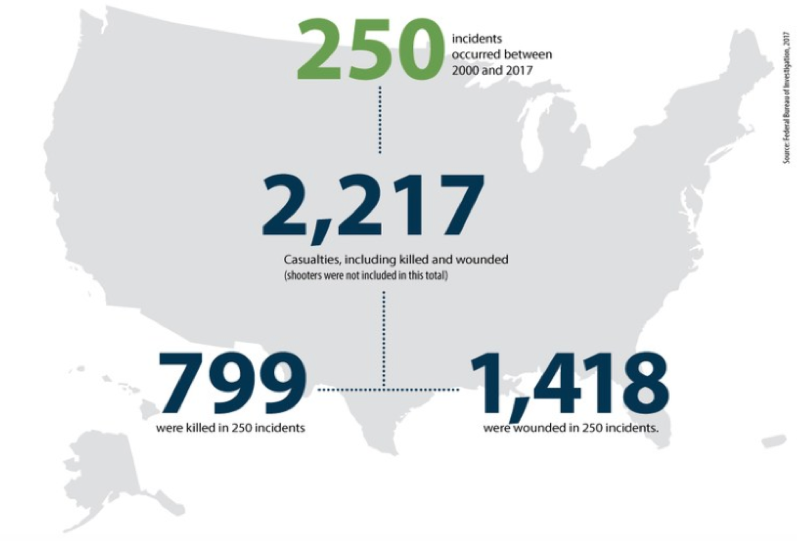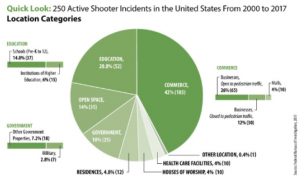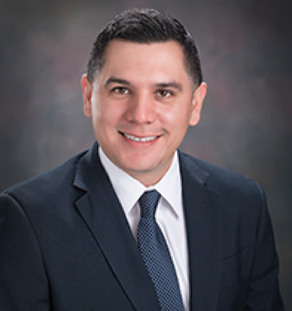Schools must be prepared to deal with an increasingly complex set of challenges that test the normal approaches to crisis management and emergency preparedness. In order to prevent the next active shooting, administrators, teachers, staff, parents, and students must work together, collectively, to promote rigorous preparedness programs that impact not only school district campuses but the entire community.
Active shooter statistics are staggering. From 2000-2017, active shooter incidents and resulting casualties have climbed at an alarming rate. According to the FBI’s study of “Pre-attach Behaviors of Active Shooters,” in 2017, there were 30 separate active shootings in the US – the largest number ever recorded by the FBI during a one-year period.

Locations of active shooter incidents vary from  Commerce (business, malls) to Education (Pre-K through 12 and Institutions of higher education). Education accounts for 20% of active shooting locations.
Commerce (business, malls) to Education (Pre-K through 12 and Institutions of higher education). Education accounts for 20% of active shooting locations.
What needs to happen next? Rather than reacting to active shooter incidents after they’ve occurred, now is time for schools to integrate with their communities to leverage their shared resources for preparedness. We know some schools are already working with law enforcement, mental health experts, counselors, social workers, teachers, and parents. Opening these lines of communication is essential – let’s take a look at how to get started.
How to engage the whole community?
- Establish a School Preparedness Committee to address not only active shooter incidents but all types of threats and hazards.
- Identify resources needed for active shooter preparedness (e.g., mental health outreach, protocols for screening and identification, intervention, youth action programs, deterrence, metal detectors, school resource officers).
- Identify resources needed to respond to and recover from active shooters (e.g., crisis management procedures, lockdown and evacuation procedures, counseling and family re-unification).
- Seek external stakeholders’ input and support (e.g., youth action programs, mental health organizations, local first responders) and incorporate into school preparedness activities.
- Integrate policies and guidelines across the school district and/or institutions to ensure a common understanding of a unified approach for preparedness and crisis management.
- Develop a training program and schedule regular exercises and drills – don’t let a plan sit on the shelf – plans need to be living documents that are continuously updated and refined as new information becomes available and as new technologies are presented.
All of these are standard requirements which unfortunately begs the question: are we meeting the bare minimum, or are we making school safety a priority for our children? Do school districts have the resources to implement a consistent, standardized approach to school safety?
These are valid questions being asked across Texas and communities throughout the country.  Schools are educating developing minds. However, as a new school year approaches and students begin to fill classrooms, will they be thinking about the lesson in front of them or their safety in case of a situation? Can parents feel comfortable leaving their child at school?
Schools are educating developing minds. However, as a new school year approaches and students begin to fill classrooms, will they be thinking about the lesson in front of them or their safety in case of a situation? Can parents feel comfortable leaving their child at school?
It should never be a child’s responsibility to divide their attentions between passing their tests and adjusting their expectations for a devastating attack on their community. Nor, for that matter, should it be the teacher’s job to divide their focus between educating and reciting active-shooter procedures in the back of their heads. But this is where we are. Alarming trends can rapidly escalate to chronic social pain unless all parties act immediately.
Emergency Preparedness 101– Strategies for Ensuring Your Organization Is Prepared for the Unexpected
Tue, Sep 18, 2018 1:00 PM – 2:00 PM EDT
Webinar Registration is Now Open Here.
Guest Speaker: Eddie Velez, Senior Manager, CohnReznick
 Eddie Velez is a Senior Manager with CohnReznick’s Disaster Response and Recovery Advisory team. Previously, he worked with FEMA Region 6 for more than 13 years where he served in the roles of: Response Division Operational Planner, Planning Section Chief for FEMA Region 6 Incident Management Assistance Team (IMAT), and a Preparedness Analyst for the National Preparedness Division. In his last position, he managed the Regional Threat and Hazards Identification and Risk Assessment process and supported synchronizing preparedness efforts with local, state, tribes, and federal partners.
Eddie Velez is a Senior Manager with CohnReznick’s Disaster Response and Recovery Advisory team. Previously, he worked with FEMA Region 6 for more than 13 years where he served in the roles of: Response Division Operational Planner, Planning Section Chief for FEMA Region 6 Incident Management Assistance Team (IMAT), and a Preparedness Analyst for the National Preparedness Division. In his last position, he managed the Regional Threat and Hazards Identification and Risk Assessment process and supported synchronizing preparedness efforts with local, state, tribes, and federal partners.
Eddie Velez, Senior Manager, Government and Public-Sector Advisory for CohnReznick LLP – eddie.velez@cohnreznick.com or 512-822-7939.
CohnReznick LLP is an accounting, tax, and advisory firm in the U.S. with a proven history of successfully executing large-scale disaster recovery programs.

